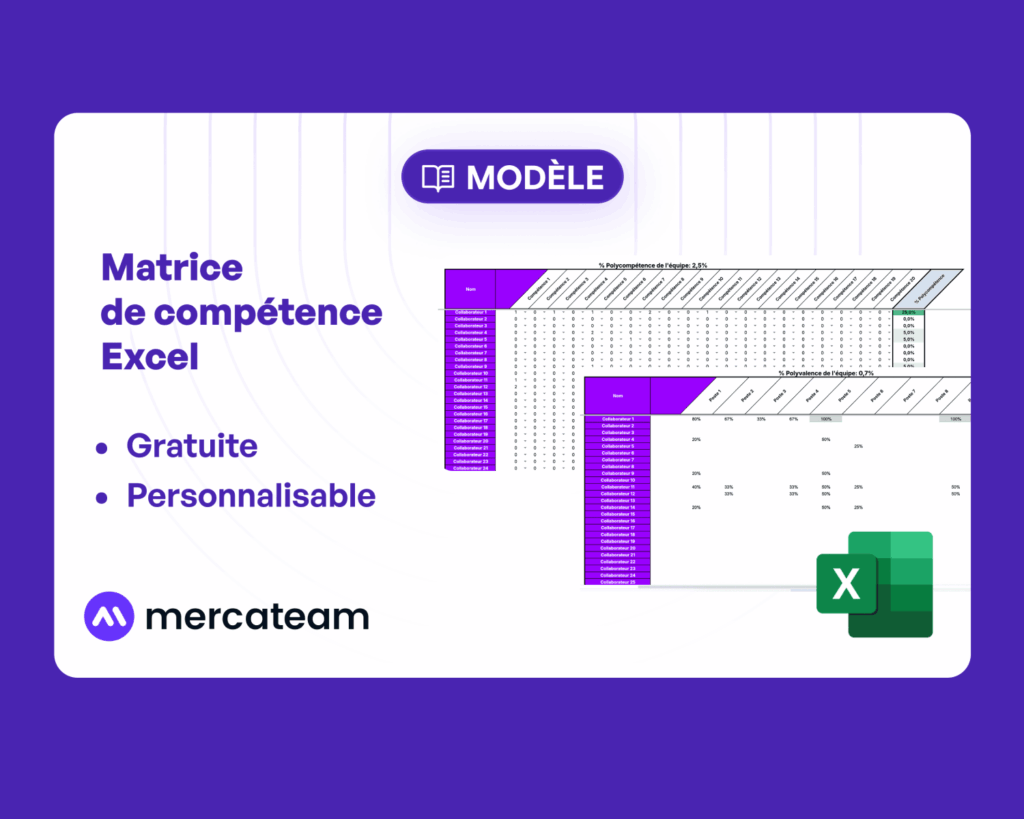Introduction
In an era of rapid and relentless business transformation, forward-looking job and skills management (GPEC GEPP) and reliable skill data from the field are proving to be crucial tools. According to a Calexa Group study, 67% of companies that have adopted proactive jobs and skills management are more successful in navigating today's economic landscape. Harmonizing these two approaches is not only strategic, it's vital to the sustainability and development of any organization. Let's dive into this fascinating world to understand how skills, data and forecasting are shaping tomorrow's business.
Find our article on : Skill data and its impact on GEPP and productivity
What is Gestion Prévisionnelle des Emplois et des Compétences (GPEC GEPP)?
Definition of GPEC GEPP
The Job and Skills Planning (GPEC) is a proactive method which aims to adapt jobs, staff and skills in the short and medium term to requirements arising from corporate strategy and changes in the economic, technological, social and legal environment. This approach takes into account all aspects of competence, including knowledge, know-how and interpersonal skills, acquired by staff within the company, in previous companies or even individually.
GPEC has become a necessity for all companies wishing to develop their jobs and skills. However, it is important to note that no two GPEC programs are alike. It is specific to each structure, depending on its sector of activity, its size and its stage of development.
The importance of GPEC GEPP in the company
GPEC is a forward-looking approach to human resources management, designed to support change. It plays a crucial role in understanding employment and skills issues and building cross-functional solutions. These solutions simultaneously meet the challenges of all the players involved: companies, regions and employees.
In other words, GPEC aligns the company's objectives with those of its employees, while anticipating and responding to external developments. It's a win-win strategy that strengthens not only the company's competitiveness, but also the personal and professional development of each employee.
How can GPEC GEPP help you anticipate business transformation?
Anticipating the transformation of professions through skills enhancement
In a world where digital transformation is progressing at lightning speed, companies are faced with the imperative of anticipating rather than undergoing the transformation of their businesses. Employment and Career Management (ECM) plays a central role in enabling companies to navigate effectively through these transformations, cultivating the agility and adaptability of their employees and structures.
It is in this context that the concepts ofupskilling and reskilling make perfect sense. These approaches focus on a candidate's motivation and interpersonal skills, rather than concentrating solely on current skills and know-how. Thanks to tailored training and transformation programs, the company can fill gaps in professions where digital skills are in short supply.
By valuing "atypical" profiles, whether among current employees or external candidates, the company can reduce the gap between existing digital skills and those needed to respond to business transformation. With this in mind, GPEC GEPP is a powerful tool for supporting change.
In addition, every six years, employers are now required to carry out a summary assessment of each employee's career path. This crucial step enables them to check that each employee has benefited from training, certification, validation of acquired experience, or salary or career progression.
However, the aim is not simply to "play by the rules". To remain competitive in the digital race, companies need to continually develop jobs and skills. Visit GPEC GEPP represents an opportunity to orchestrate professional development that benefits both the individual and the company.
Steering business transformation using HR indicators
In the current context of digital transformation of businessesIt is essential for companies to monitor their development through key indicators. Visit HR data offer valuable insight into which areas need priority attention, in order to align current skills with future needs.
To achieve this, companies rely on various indicators such as turnoverthe absenteeism ratethe age structuretypes of employment contractsthe rate of trainingof conversionand promotion. With modern HR software, this information can be segmented by department or by socio-professional category. This makes it possible to identify groups of employees requiring special attention in terms of GPEC GEPP.
Two types of indicators are used to measure the effectiveness of the GPEC GEPP system:
Quantitative indicators GPEC GEPP These indicators help to determine whether the objectives initially set have been achieved. They take into account aspects such as the number of HR processes integrating PPIM work and the frequency of job updates.
Qualitative indicators GPEC GEPP These indicators measure the degree of acceptance by the various stakeholders. They assess the involvement of managers, training managers and employees themselves.
The judicious use of HR indicators, combined with rigorous monitoring, can enable companies to successfully navigate the business transformation process based on GPEC GEPP.
Personalized support with GPEC GEPP
Faced with the rapid transformation of professions and skills required by digital transformation, traditional approaches to human resources management, notably the "one size fits all" concept, are proving increasingly unsuitable. To meet this challenge, GPEC GEPP is moving towards an iterative, personalized approach.
One of the key tools in this new dynamic is theadaptive learning or "adaptive learning". This approach makes it possible to integrate diverse profiles into the company, even if they don't fit conventional criteria. Instead of favoring stereotypical career paths (high-school diplomas, experience in a specific field), this approach values the adaptability and flexibility of the candidate.
Take, for example, a professional who started his career in a completely different discipline, say, the arts or sociology. Thanks to his or her open-mindedness, curiosity and self-study through online courses, this professional has succeeded in acquiring technical IT skills. This enables them to bring a fresh perspective and a different approach to solving complex problems. This type of profile, with its ability to think outside the box and adapt to a variety of contexts, can rise to unexpected challenges. Their dynamism and motivation in the face of new challenges can become a driving force for the team as a whole.
Personalized support within the framework of GPEC GEPP, although requiring a certain maturity on the part of companies, makes it possible to embrace these atypical career paths and to develop a diversity of skills, essential to competitiveness and innovation.
Drawing up a Communication Plan for GPEC GEPP
As with any major corporate project, implementing GPEC GEPP requires clear, transparent and effective communication. As soon as GPEC GEPP is launched, a communication plan must be drawn up to ensure that all company players are well informed and involved.
Proactive communication avoids the speculation and misunderstandings that can arise if information is circulated solely through informal discussions. This communication can take many forms: articles on current projects, testimonials from those who have already benefited from GPEC GEPP, interviews with tutors and their mentees, etc.
A key challenge for GPEC GEPP is to create a link between the company's strategy and the reality on the ground, between the present and the future. To achieve this, it is crucial to minimize the distance between the place where decisions are made and the field where transformations are carried out. Effective communication facilitates this connection by enabling all stakeholders to understand the purpose of GPEC GEPP, its implications for the company and for themselves, and their role in its implementation.
The best time to launch or reinvigorate GPEC GEPP is when all the indicators are in the green: the company is in good health, HR functions are efficiently performed, and there are opportunities for business or activity evolution. A well-developed communication plan for GPEC GEPP helps to align all these variables, maximizing GPEC GEPP's potential for success.
Interconnecting GPEC GEPP and Skill Data for Proactive Skills Management
The new digital era has brought with it an influx of data, including in the field of human resources. This 'Skill Dataor skills data, can be used to optimize skills management within a company. By combining skills data with GPEC GEPP, it is possible to implement more proactive skills management.
Visit competency data provide a detailed overview of the skills available within the company, who holds them, at what level, and how they are evolving. They are a valuable resource for PPIMwhich aims to anticipate and manage changes in jobs and skills within the company.
The interconnection of the GPEC GEPP and competency data can be achieved in several ways. On the one hand, skills data can enrich GPEC GEPP analyses, helping to identify trends and gaps between currently available skills and those that will be needed in the future. Secondly, the results of the GPEC GEPP can guide the collection and analysis of skills data, identifying, for example, which skill areas should be closely monitored.
In short, the interconnection of the GPEC GEPP and competency data enables us to move from reactive skills management, based on immediate needs, to proactive management, which anticipates future needs and prepares the company to meet them. This approach obviously requires appropriate tools to collect, analyze and interpret skills data, but the potential benefits for the company are considerable. According to a McKinsey Global Institute study, 82% of executives say that reskilling and upskilling are at least half the solution to the skills shortage caused by automation and artificial intelligence.
Job and Career Management, combined with Skill Data, offers companies proactive and strategic skills management. In this way, they can successfully adapt to the digital transformation of their businesses. In short, this approach places people at the heart of corporate strategy, where the evolution and adaptability of skills are essential to overall performance.




